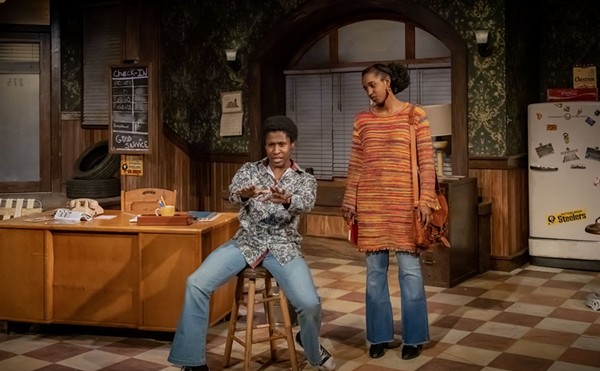Painting is far from "dead." But in many art schools, it's barely alive, even if — judging from gallery guides and publications like the quarterly New American Paintings — it is more popular now than it has been since the mid-1980s.
At the Cleveland Institute of Art, a national trend in art education toward an ever more exclusive emphasis on conceptually based art has accompanied the implementation and growth of the school's technologically oriented T.I.M.E. Department. That traditional forms are destined to be seen as pit stops en route to a world utterly transformed by technology is probably inevitable and necessary. But still ... there are at most three or four paintings in a show of perhaps a hundred works by 43 CIA faculty members. Sculpture and ceramics play a slightly larger role, due to the presence at the school of versatile, first-rate artists like Barbara Stanczak, Brent Kee Young, Judith Salomon and William Brouillard.
There is one painting that really looks like a painting, aptly called "Picturing Paint" by Sarah Sutton — a large-scale oil-on-canvas abstraction. That the work is based on a digital scan of painted red and blue swashes makes it respectable but doesn't change the fact that Sutton has produced a painting. My point: It happens that some of CIA's best-known and most bragged-about alumni — from Robert Mangold to Dana Schutz — are painters, and it seems a shame to "virtually" dismantle one of the school's most successful departments.
But there are many other works in this hip and thought-provoking (if paint-deprived) show that catch the mind in a firm grip of materials and imagery. Dan Tranberg's three ascetic yet tender small studies executed in acrylic paint and thread on paper share common ground with painting, drawing and collage. In two of these works, the presence of thread, playing the part of drawn lines, sketches the sort of paradox that art has always dealt with — questioning the conflicting nature of sensual information. And there is Kasumi's mind-blowing, 12-foot-long, untitled Xerox scroll, reproducing what appears to be an alien landscape or possibly a micro-photograph of some polyp-like structures (it's actually a finger dance, performed in relation to the movement of the machine's scanner). Greg Martin's series of wet-plate collodion photographic self-portraits "Staring at the Sun" are also indefinably haunting and haunted, evoking the thick shades of human presence stirred into time.
Another ghost at this year's faculty show is the grid. The late modernist CIA building itself is a self-conscious grid, and many artists working at the school still use a sectional, geometrically analytical structure to frame and order their aesthetic explorations. In a work called "Floor Excavation," fiber artist Tina Cassara pried up parquet squares from the gallery floor, interrupting the grid and exposing a graphically powerful swirl of black adhesive — the underbelly of geometric order. At a time when CIA is being revamped and deconstructed, Cassara's intervention carries a clear message.











